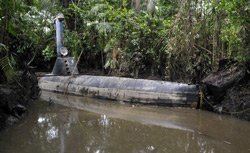?/?
explainer
?:?
Answers to your questions about the news.Posted Tuesday, Sept. 27, 2011, at 6:26 PM ET Officials in Colombia have discovered two drug-smuggling submarines since Friday. One of the vessels was big enough to carry four tons of cocaine and a five-person crew, and could remain underwater for up to 10 days. Most submarines belong to military forces or deep-sea research teams. Can you buy your own personal sub?
Officials in Colombia have discovered two drug-smuggling submarines since Friday. One of the vessels was big enough to carry four tons of cocaine and a five-person crew, and could remain underwater for up to 10 days. Most submarines belong to military forces or deep-sea research teams. Can you buy your own personal sub?
Yes. Several businesses in the United States and Europe cater to the recreational submariner. Around $600,000 will get you an entry-level, winged submersible without a pressurized cabin. These vessels can be launched from a ramp or beach and are highly maneuverable. They can barrel-roll and even leap out of the water. But they're not great for exploring. They don't go very deep, they have to keep moving to stay submerged, and the view of the sea floor is limited. If you're willing to spend $2 million, you can buy a two-person submersible with a see-through acrylic dome. (They look very much like George Jetson's flying car, although they don't fold into a briefcase. In fact, they have to be towed out to sea by a yacht.) These models can dive to 1,000 feet. Those who want to dive in high style can purchase a ritzy, 5,000-square-foot submarine with a living and dining area for $80 million. James Cameron, Paul Allen, and Russian oil tycoon Roman Abramovich are all reportedly recreational submariners.
Manufacturers of recreational subs put new owners through a three-week training course. (Some buyers have their yacht captain take the training course in their stead.) In most models, the tricky part is taking just enough water into the ballast tanks to achieve neutral buoyancy, so that the boat won't rise or fall in the water until the operator initiates the thrusters. Once the ship is submerged, driving is pretty intuitive. A joystick moves the ship left, right, forward, and backward. Twist the stick to rotate the sub. A switch makes the vessel rise or fall.
If you're in the market for a personal submersible, you'll have to decide how deep you'd like to go. Achieving greater depth requires stronger materials and construction, which add substantially to the price tag. For example, a Triton sub rated to 3,300 feet costs $1 million more than the 1,000-foot-rated model, a 50-percent price hike. If you have the money, though, it's probably worth it. There's very little light at the more significant depths, which means virtually no sea vegetation and greatly increased visibility using the vessel's headlights. The sea creatures at that depth are completely different, as they have adapted to a zero-light environment. Your extra million would even buy you the chance, albeit a slim one, of spotting a giant squid. There's the added bonus that you could be a genuine explorer?there are plenty of ocean areas that no human has ever explored at that depth.
If you don't have a couple of million dollars lying around, don't give up hope. A small community of hobbyists around the world have built recreational submersibles in their backyards and garages. Some of the designs are quite sophisticated, and private builders have managed to dive to nearly 1,000 feet. Skilled individual builders can put a submersible together in three to five years, and the parts for a two-man model cost about $50,000. Costs vary widely, however, because some enthusiasts are pretty good at adapting discarded parts from other products. There is some danger in this business, though. Hobby submariners have died when their pride and joy cracked at depth. (There has never been a recorded death in a commercially-made private or tourist submarine.)
If you build your own sub, you'll need to get Coast Guard approval before diving at sea. You don't need preapproval to explore a lake, but it's a good idea to contact the FBI beforehand anyway. Recreational submarining is still extremely rare, and local people have been known to call the police when they see a mysterious vessel surface near their vacation home.
Got a question about today's news? Ask the Explainer.
Explainer thanks naval architect Jay Jeffries, Bruce Jones of Triton Submarines, and Charlotte Schroots of U-Boat Worx.
Like Slate and the Explainer on Facebook. Follow us on Twitter.
Brian Palmer is a regular Slate contributor. He can be reached at . Follow him on Twitter.Photo by Luis Robayo/AFP/Getty Images.
Source: http://feeds.slate.com/click.phdo?i=dace0ee809b8557c253e0aed758cdf8c
daphne guinness daphne guinness mortgage rates mortgage rates matthew shepard matthew shepard kirstie alley
No comments:
Post a Comment
Note: Only a member of this blog may post a comment.